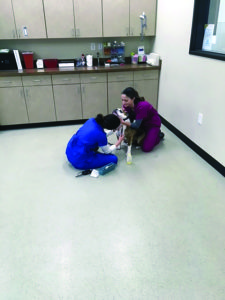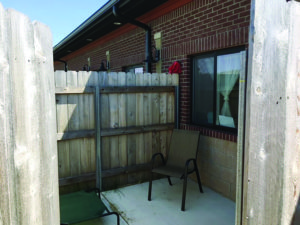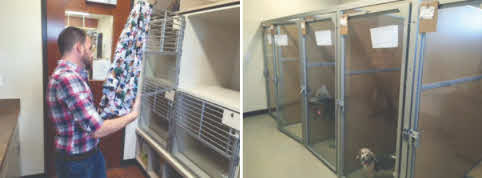Featured Low Stress Handling Clinic:
Zionsville Country Veterinary Clinic (Whitestown, IN)
I met Dr. Shari Lyons many years ago at a women’s veterinary practice owners retreat in Louisville, Kentucky. I lost touch with her over the years, but we reconnected when she contacted me about bringing more Low Stress Handling® training into her clinic. As a way of kickstarting that process, she attended my first Master Class Weekend in Tuscola, IL, and she brought photos of her clinic, as attendees tend to do, to discuss ways to enhance the space for a less stressful veterinary experience. Her new clinic had been newly constructed following the Fear Free practice guidelines and was enhanced ny Dr. Lyons’ Low Stress Handling® Certification expertise. I thought it would be great to share with you the design of a newly constructed clinic built with low stress, high quality patient care in mind.
Zionsville Country Veterinary Clinic was outgrowing its original space and constructing a new clinic nearby was the best option for business growth. Dr. Lyons understood that the clinic had to incorporate both functionality and patient stress reduction in the design. The process of drawing out exam rooms, lobby, treatment areas, wards, and other areas with staff input took over a year. Slight changes in material choice and room arrangement can make a significant difference. Many hours were spent with pencil and paper before breaking ground in 2016. This beautiful new clinic was open eleven months later to serve her clients.
Driving up to the clinic, I could see not only the separate dog and cat entries, but also deep overhangs which create a porch-like space, sheltering patients and owners from both sun and inclement weather. Comfortable benches outside provide an extra waiting area for animals that may be stressed in the waiting room which helps to control stress in the lobby area. Zionsville Country Veterinary Clinic is a place where clients can bring their dog to the clinic for a few treats and then go home – a visit with no stress. Entering the clinic, the vestibule has a large window looking into the waiting area making it is easy for clients and staff to see who is there and avoid any pet confrontations. A basket of pheromone-infused bandanas awaits in the vestibule and clients can easily take one to enhance a low stress visit.
The reception desk is far enough away from the entry doors to avoid the all-to-common client bottleneck we all hate. The vaulted ceiling area is amazingly quiet due to the rubber flooring which runs throughout the clinic. A library-like reading area is off to the side of the waiting area and is used for presentations and educational events.
A canine exam room hallway and separate feline exam room hallway run parallel to each other. Luxury vinyl plank flooring, which adds a distinctive look, covers the feline area as the traction needs are not as great as that for canines. The rubber flooring in the canine wing, however, looks like high grade commercial vinyl and is very quiet and comfortable to stand on. The reduction of noise from footsteps, equipment, and phones was also impressive. This flooring also runs throughout the rest of the clinic. Noise cancelation is traditionally difficult to accomplish in veterinary clinics because we need surfaces that are easy to clean like stainless steel, laminate, drywall, and other sound reflective surfaces. The dogs and cats in all the clinic areas were not barking or meowing as much as other clinics and I think that was due to a lot less environmental noise. I don’t think we realize how much environmental noise affects our patients. Flooring choices make an enormous difference in this respect.
The exam rooms feel much bigger, despite how small they are. Cantilevered tables that flip up help create this spacious feeling. All the exam rooms have towels to cover the table top providing a warm comfortable surface for exams. The feline rooms have windows and perches as well for the cats to enjoy the space.
An outdoor canine exam room rounds out the canine care are. It consists of a grassy yard enclosed with privacy fencing and a picnic table, chairs, and an umbrella for shade. A separate door into the canine treatment area can bring a dog inside as needed for diagnostic procedures. This area provides a quiet space for staff, clients, and patients while blocking parking lot traffic and the possible sighting of any other dogs or people for reactive and stressed dogs. It is often difficult to try to find or create a space like this in many of our practices, but it is a space that is more often than not needed in many veterinary practices. Having a quiet space like this is very helpful, especially when we seek to be outside. While Indiana winters can pose a bit of a challenge to using this area, routine care of dogs who need this area can be scheduled during the spring, summer, and fall months. I imagine this space can also be used for other purposes where a family may want to spend time with a sick pet or for end of life or euthanasia discussions.
The treatment area has open floor space in the corner for floor exams. While I was there, I was able to witness a very happy English bulldog having his blood drawn. Secure footing from the floor and Low Stress Handling® provided a good patient and staff experience. A ceiling track with curtains is planned to provide more privacy and block the view of other animals and people. Radiology, ICU, surgery, and other areas spin off this area like many treatment spaces. Enclosing these areas in rooms with large windows reduces noise and movement stimulus.
The animal care wards are quiet due to the rubber flooring and the use of laminate vs. stainless steel cages. The laminate cages are durable, significantly reduce noise, provide warmth, and are flexible in design. Cage stress is relatively common in both dogs and cats. The noise of clanking cage doors, banging wagging tails, and reflections in the metal increase cage distress. In the clinics who have used the laminate cages, I have not seen damage or additional wear and tear than on stainless cages. I personally think that laminate cages and runs should be the standard of low stress hospital design.
Zionsville also considered reducing staff stress by providing personal spaces. The doctors have private office space to make calls, write up records, and think. In many clinics, office space is often a cramped corner shared with others and overflowing with storage. We only spend a little time here, but we need this space for communication and a personal break. As I interviewed Dr. Lyons about her experience in embracing Low Stress Handling® and building her new clinic, I listened to her journey about how she incorporated her knowledge of Low Stress Handling® in the design, reminding me of how the veterinary care experience is a process that is always changing – one that has many steps that are both creative and ever evolving.
I hope you are able to take some ideas and inspiration from this clinic’s low stress design. Some of the described features are relatively easy to install in established clinics, too.
For Further Reading:
- Low Stress Emergency Care – Is It Possible? Yes!
- Tactile Learning & Low Stress Handling: The Steps from Learning to Doing
- Are You in a North/South Workplace?
- Veterinarians & Technicians – Partners in Care like Partners in a Dance






